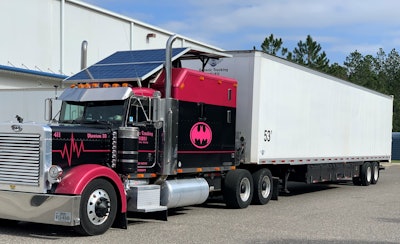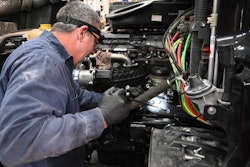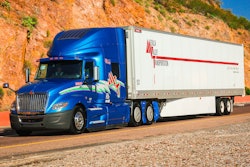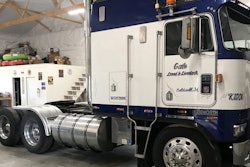 Got your own example of a do-it-yourself solution to a problem related to truck equipment or the owner-operator business? Send your story to [email protected] with the “highway hacks” subject line.
Got your own example of a do-it-yourself solution to a problem related to truck equipment or the owner-operator business? Send your story to [email protected] with the “highway hacks” subject line.Another creative solution to electrical needs during downtime to eliminate any need to idle the big diesel comes from Conway, Ark.-based owner-operator Chad Fowler’s “Solar Peterbilt.” The 1996 short-hood 379 is modified to look a little more like a long-hood. The custom hood work Fowler and a crew made up of close associates did to it, however, it isn’t the principal head-turner when it comes to the truck.
Fowler powers the Dometic Atwood roof HVAC, two refrigerators and other appliances in his Double Eagle sleeper in part with four home solar panels ($220 apiece, manufactured by Suntech, and generating about 1,100 watts maximum) feeding an auxiliary battery bank, he says. “You can’t just slap solar panels on and expect to power everything. Your battery bank is your most important investment.”
 Chad Fowler’s “Solar Peterbilt” turns heads on the road for its solar installation on the roof of the 1996 379. That’s not, however, the only custom design work he’s put into it. The paint scheme draws on his personal history, from the batman logo in memory of young Sammy Bates, his ex-wife’s son, who passed away way too early. Fowler’s father then passed in 2015, so “I run his CB handle on my hood: Phantom 33.” The 33 is after the first truck the elder Fowler ever drove, truck No. 33 in the fleet of Frozen Food Express in Texas. Fowler runs with five other owner-operators leased to small fleet Generic Trucking.
Chad Fowler’s “Solar Peterbilt” turns heads on the road for its solar installation on the roof of the 1996 379. That’s not, however, the only custom design work he’s put into it. The paint scheme draws on his personal history, from the batman logo in memory of young Sammy Bates, his ex-wife’s son, who passed away way too early. Fowler’s father then passed in 2015, so “I run his CB handle on my hood: Phantom 33.” The 33 is after the first truck the elder Fowler ever drove, truck No. 33 in the fleet of Frozen Food Express in Texas. Fowler runs with five other owner-operators leased to small fleet Generic Trucking.Before going out on the road as an owner-operator about six years ago, owner-operator Fowler spent two decades as a diesel mechanic. “I worked on about a million diesel APUs,” he says; they seemed to “always break down,” so he didn’t want to go that route to eliminate idling. Fowler’s search for mostly maintenance-free electric power led him to the batteries he’s using today: twelve 6-volt golf cart batteries “aligned in a series,” he says, and housed in battery boxes on either side of the truck as well as in an extra tool box on the driver side of the truck. Run through an inverter, the power generated “gives me the power to sit around and not idle for anything. I run my kitchen, my heat, my air and everything else on that.”
Even with some early experimentation with deep-cycle marine-style batteries and more trial and error with the system, his total investment in equipment for the system was just around $4,000, well below many purpose-built auxiliary power unit systems that run on diesel. The four solar panels cost $220 apiece, and Fowler worked with a team of friends and close associates at home to do the install himself, saving on that cost.
Owner-operator Bob Caffee has shown, too, that solar can provide most of the necessary power needs on the road, though he and his wife, Linda, also run with an Onan generator as a backup, as Bob wrote in this recent post in the Team Run Smart blog series. As with Fowler and a gas-powered generator he once used, a similar generator on a previous truck had been the Caffees’ primary power source when stopped before their current set-up. Their custom-designed system includes a Xantrex inverter, a MorningStar charge controller, eight Northstar batteries, and three 330-watt solar panels from Merlin Solar, whose products include flexible designs that can conform to the curve of a tractor’s roof, among other options.
A charge controller is key for any solar system, Fowler emphasizes. His own, from OutBack Power, Inc., effectively regulates the power coming from the panels to the battery bank. For starting the truck, he uses a Group 31-size starting module like those made by Maxwell Technologies – it operates independently of those house golf-cart batteries for the sole purpose of starting the truck.
“My truck turns over faster than it’s ever turned over with a regular battery system,” Fowler says, “and that saves your starter.”
Ultimately, he adds, “there’s a science to this business. You’ve just gotta get it figured out.”
He and Caffee both point to a misconception about solar — that hot, sunny climates/seasons are the only optimal times to use it — they hope anyone considering this kind of system will keep in mind. As Caffee put it in his recent blog post, “That is false. We have found that parking under a streetlight will generate small amounts of power” overnight, even, and a cool and clearer sunny day is often more productive that a hot one.
Fowler estimates that the first year he was running his system he may have saved as much as $15,000-$20,000 in fuel not idling.
Bob Caffee believes he may have finally found maintenance-free power with the system, working with Toby Tuckley at Bergstrom Solar Energy Systems on the design.
Find more about the Caffees’ system via this link, and you can connect with Chad Fowler via his Solar Peterbilt Facebook group.










